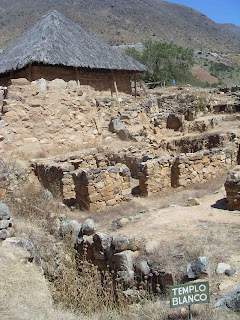10pm Thursday July 28, 2011
¡Feliz Día de Patría! Today was Peruvian Independence day. What does that mean? Constant parties and fireworks for the last week; not the nice colorful fireworks, but rather the fireworks that are loud and annoying when you’re trying to teach a Hebrew class in the evening and you keep getting interrupted.
The last two days were particularly adventurous and active. Yesterday (Wednesday) I along with Miguel, a member of the community, one of his friends, and 6 random French and Belgian women decided to hike up to the peak of Sierra San Cristobal, where a chapel and giant white cross stand. On the Day of Virgin Mary, there is a Huanuqueñan tradition to make a pilgrimage to this particular peak. At the peak they light candles for the Virgin Mary and have all sorts of festivities at the peak including dances, festive food, and food sacrifices to Pachamama.
It was much more strenuous than the hike I had done alone, because when I had hiked alone, I didn’t want to do anything too risky. But with 8 people, we had enough water, food and phones in case of an emergency. Nonetheless, it wasn’t particularly reassuring to see several tombs of pilgrims who had died hiking on the way up. It took 2.5 hours on the way up, and 1.5 on the way down. I’m not sure my feet have ever been this callused. I also applied sunscreen every half hour, and somehow was able to get badly sunburned. Nonetheless, the views from the top and the photo op with the cross were just spectacular.
¡Feliz Día de Patría! Today was Peruvian Independence day. What does that mean? Constant parties and fireworks for the last week; not the nice colorful fireworks, but rather the fireworks that are loud and annoying when you’re trying to teach a Hebrew class in the evening and you keep getting interrupted.
The last two days were particularly adventurous and active. Yesterday (Wednesday) I along with Miguel, a member of the community, one of his friends, and 6 random French and Belgian women decided to hike up to the peak of Sierra San Cristobal, where a chapel and giant white cross stand. On the Day of Virgin Mary, there is a Huanuqueñan tradition to make a pilgrimage to this particular peak. At the peak they light candles for the Virgin Mary and have all sorts of festivities at the peak including dances, festive food, and food sacrifices to Pachamama.
It was much more strenuous than the hike I had done alone, because when I had hiked alone, I didn’t want to do anything too risky. But with 8 people, we had enough water, food and phones in case of an emergency. Nonetheless, it wasn’t particularly reassuring to see several tombs of pilgrims who had died hiking on the way up. It took 2.5 hours on the way up, and 1.5 on the way down. I’m not sure my feet have ever been this callused. I also applied sunscreen every half hour, and somehow was able to get badly sunburned. Nonetheless, the views from the top and the photo op with the cross were just spectacular.

The Chapel and Cross of San Cristobal on the mountain peak
Me on an altar on the peak
Self Explanatory
Today (Thursday), Rolo, Carmen and I traveled 3 hours north into the forest to the National Park of Tingo Maria. Until today I had never been inside a cave, but the main attraction in Tingo Maria is the Cueva de la Lechuza (Cave of the Owl), so today made it my first. Bats, owls, giant harmless spiders, and tourists could all be found inside the cave. We also visited the Cave of the Turkey and a dilapidated zoo that had awkward cages for the animals that didn’t even attempt to simulate their own habitat. I couldn’t help but crack up upon seeing the leopard sitting on a wooden table eating meat, with a wooden chair on the left.
Cueva de la Lechuza (Cave of the Owl)
Rolo and I in the Cueva de la Lechuza (Cave of the Owl)
National Forest of Tingo Maria



































